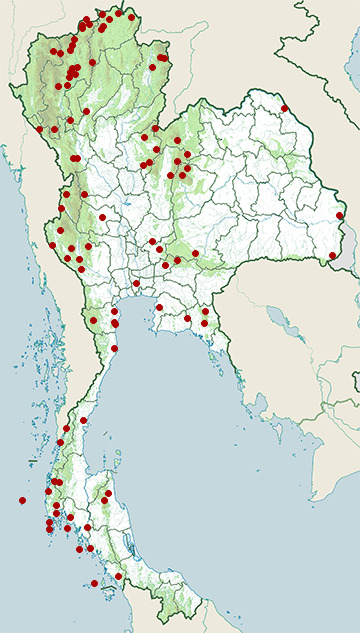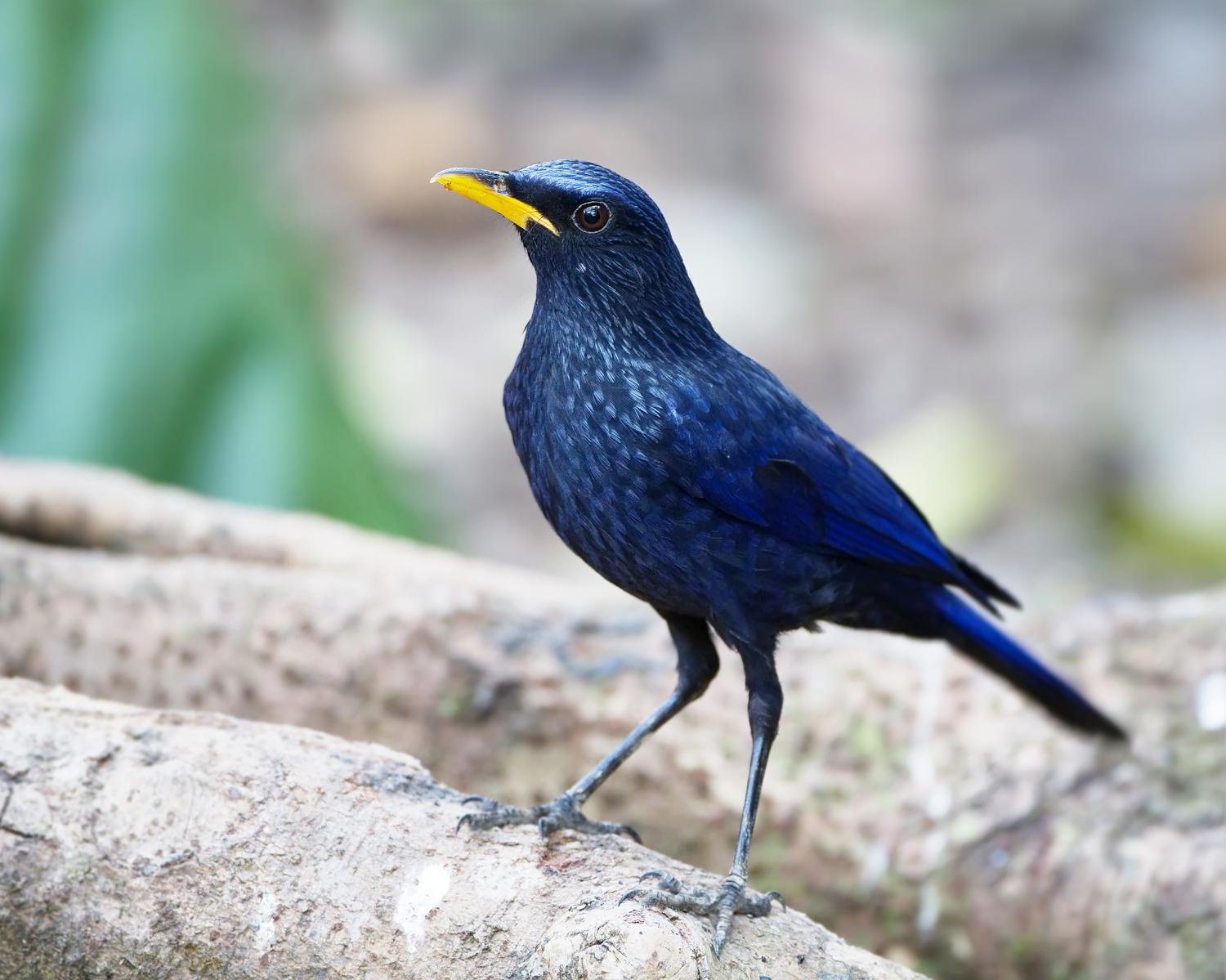Species of Thailand
Blue whistlingthrush
Myophonus caeruleus
Giovanni Antonio Scopoli, 1786
In Thai: นกเอี้ยงถ้ำ
The blue whistling thrush (Myophonus caeruleus) is a whistling thrush that is found in the mountains of Central Asia, South Asia, China and Southeast Asia. It is known for its loud human-like whistling song at dawn and dusk. The widely distributed populations show variations in size and plumage with several of them considered as subspecies. Like others in the genus, they feed on the ground, often along streams and in damp places foraging for snails, crabs, fruits and insects.
Description
This whistling thrush is dark violet blue with shiny spangling on the tips of the body feathers other than on the lores, abdomen and under the tail. The wing coverts are a slightly different shade of blue and the median coverts have white spots at their tips. The bill is yellow and stands in contrast. The inner webs of the flight and tail feathers is black. The sexes are similar in plumage.
It measures 31 - 35 cm in length. Weight across the subspecies can range from 136 to 231 g. For comparison, the blue whistling thrush commonly weighs twice as much as an American robin. This species is possibly the largest extant thrush though size overlap does occur with the similar by length great thrush and the insular Amami thrush, whose mean body mass falls around the middle of those of the whistling thrush. Among standard measurements, the wing chord can measure 15.5 - 20 cm long, the tarsus is 4.5 - 5.5 cm and the bill is 2.9 - 4.6 cm. Size varies across the range with larger thrushes found to the north of the species range and slightly smaller ones to the south, corresponding with Bergmann's rule. In northern China, males and females average 188 g and 171 g, whereas in India they average 167.5 g and 158.5 g.
Several populations are given subspecies status. The nominate form with a black bill is found in central and eastern China. The population in Afghanistan, turkestanicus, is often included in the widespread temminckii which has a smaller bill width at the base and is found along the Himalayas east to northern Burma. The population eugenei, which lacks white spots on the median coverts, is found south into Thailand. Cambodia and the Malay peninsula have crassirostris, while dichrorhynchus with smaller spangles occurs further south and in Sumatra. The Javan population, flavirostris, has the thickest bill. The subspecies status of several populations has been questioned.
Habitat and distribution
It is found along the Tian Shan and Himalayas, in temperate forests and subtropical or tropical moist montane forests. The species ranges across Afghanistan, Bangladesh, Bhutan, Cambodia, India, Indonesia, Kazakhstan, Laos, Malaysia, Myanmar, Nepal, Tajikistan, Thailand, Tibet, Turkmenistan, and Vietnam. They make altitudinal movements in the Himalayas, descending in winter.
Behaviour and ecology
The blue whistling thrush is usually found singly or in pairs. They hop on rocks and move about in quick spurts. They turn over leaves and small stones, cocking their head and checking for movements of prey. When alarmed they spread and droop their tail. They are active well after dusk and during the breeding season (April to August) they tend to sing during the darkness of dawn and dusk when few other birds are calling. The call precedes sunrise the most during November. The alarm call is a shrill kree. The nest is a cup of moss and roots placed in a ledge or hollow beside a stream. The usual clutch consists of 3 to 4 eggs, the pair sometimes raising a second brood. They feed on fruits, earthworms, insects, crabs and snails. Snails and crabs are typically battered on a rock before feeding. In captivity, they have been known to kill and eat mice and in the wild have been recorded preying on small birds.
This article uses material from Wikipedia released under the Creative Commons Attribution-Share-Alike Licence 3.0. Eventual photos shown in this page may or may not be from Wikipedia, please see the license details for photos in photo by-lines.
Category / Seasonal Status
Wiki listed status (concerning Thai population): Resident and winter visitor
BCST Category: Recorded in an apparently wild state within the last 50 years
BCST Seasonal statuses:
- Resident or presumed resident
- Non-breeding visitor
Scientific classification
- Kingdom
- Animalia
- Phylum
- Chordata
- Class
- Aves
- Order
- Passeriformes
- Family
- Muscicapidae
- Genus
- Myophonus
- Species
- Myophonus caeruleus
Common names
- Thai: นกเอี้ยงถ้ำ
Conservation status

Least Concern (IUCN3.1)
Photos
Please help us review the bird photos if wrong ones are used. We can be reached via our contact us page.
Range Map

- Ao Phang-Nga National Park
- Bangkok Province
- Cha-Am District, Phetchaburi
- Chaloem Rattanakosin National Park
- Chat Trakan Waterfall National Park
- Chiang Dao District, Chiang Mai
- Chiang Dao Wildlife Sanctuary
- Chiang Khong District, Chiang Rai
- Doi Chong National Park
- Doi Inthanon National Park
- Doi Lang
- Doi Lo District, Chiang Mai
- Doi Pha Hom Pok National Park
- Doi Phu Kha National Park
- Doi Suthep - Pui National Park
- Erawan National Park
- Fang District, Chiang Mai
- Hat Chao Mai National Park
- Huai Nam Dang National Park
- Kaeng Khoi District, Saraburi
- Kaeng Krachan National Park
- Khao Chamao - Khao Wong National Park
- Khao Khitchakut National Park
- Khao Laem National Park
- Khao Luang National Park
- Khao Nan National Park
- Khao Nang Phanthurat Forest Park
- Khao Phra - Bang Khram Wildlife Sanctuary
- Khao Sam Roi Yot National Park
- Khao Soi Dao Wildlife Sanctuary
- Khao Sok National Park
- Khao Yai National Park
- Khon San District, Chaiyaphum
- Khun Chae National Park
- Khun Korn Forest Park
- Khun Nan National Park
- Ko Lanta National Park
- Kra Buri District, Ranong
- Lam Nam Kok National Park
- Lan Sang National Park
- Mae Ai District, Chiang Mai
- Mae Chan District, Chiang Rai
- Mae Fa Luang District, Chiang Rai
- Mae Moei National Park
- Mae Ping National Park
- Mae Rim District, Chiang Mai
- Mae Wong National Park
- Mueang Chiang Mai District, Chiang Mai
- Mueang Chumphon District, Chumphon
- Mueang Krabi District, Krabi
- Mueang Nakhon Nayok District, Nakhon Nayok
- Mueang Phang Nga District, Phang Nga
- Mueang Phetchaburi District, Phetchaburi
- Mueang Phuket District, Phuket
- Mueang Ranong District, Ranong
- Nam Nao National Park
- Noen Maprang District, Phitsanulok
- Nong Bong Khai Non-Hunting Area
- Nong Plak Phra Ya – Khao Raya Bangsa Non-Hunting
- Omkoi Wildlife Sanctuary
- Op Khan National Park
- Pai District, Mae Hong Son
- Pha Daeng National Park
- Pha Taem National Park
- Phi Phi Islands
- Phu Chong Na Yoi National Park
- Phu Hin Rong Kla National Park
- Phu Khiao Wildlife Sanctuary
- Phu Kradueng National Park
- Phu Langka National Park
- Phu Luang Wildlife Sanctuary
- Phu Suan Sai National Park
- Sai Yok District, Kanchanaburi
- Sai Yok National Park
- Sakaerat Environmental Research Station
- San Sai District, Chiang Mai
- Si Racha District, Chonburi
- Similan Islands
- Sri Nakarin Dam National Park
- Sri Phang Nga National Park
- Taksin Maharat National Park
- Takua Pa District, Phang Nga
- Tarutao National Marine Park
- Tat Mok National Park
- Thalang District, Phuket
- Tham Pratun Non-Hunting Area
- Tham Sakoen National Park
- Thong Pha Phum National Park
- Thung Salaeng Luang National Park
- Thung Yai Naresuan Wildlife Sanctuary
- Umphang Wildlife Sanctuary
- Wat Tham Erawan Non-Hunting Area


